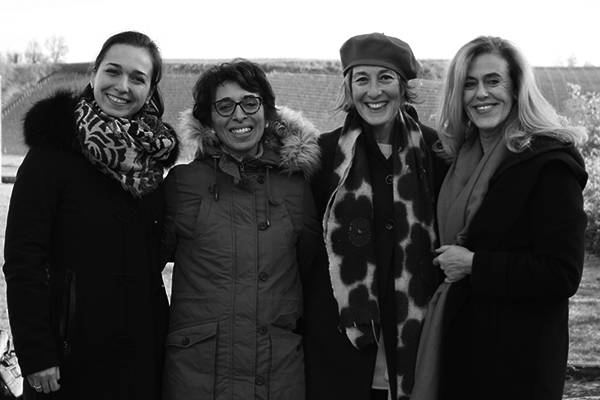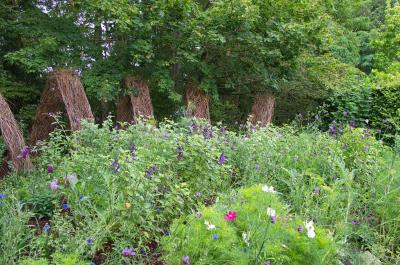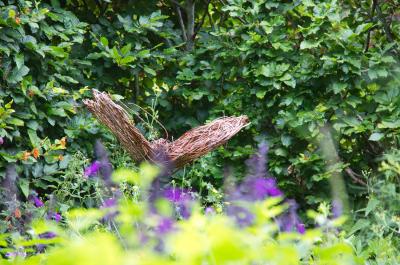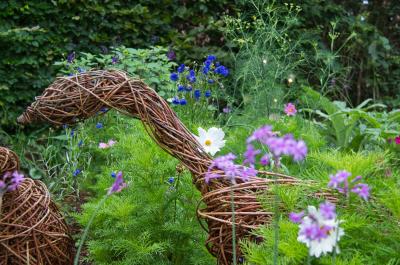12. Hortus vitae

The egg represents the perfection and harmony of nature. The origin of all living things, it symbolises fertility. Here, an unusual ornamental kitchen garden is laid out in the shape of an egg. It is quite different from traditional kitchen gardens as the ornamental plants are mixed in with the vegetables. This nourishes both body and spirit to create an “impressionist” garden in a jumble of colour and scent. On the other side of the garden path a wild garden is laid out as a wild-flower meadow. The ornamental kitchen garden and the wild garden are two different aspects of Mother Earth, but nonetheless, they have variety and a mix of species in common. They demonstrate a harmonious and balanced coexistence. The plants are not just chosen for aesthetic reasons, the choice is driven by a durable, eco-friendly vision and aims to highlight biodiversity. The pergola and animals, all made of woven willow, act as a link between the visitor and the plant world. Strolling between them becomes an experience that is sensual, immersive and educational. It makes you rethink the relationship between humanity and nature and opens new horizons, for a potential rebirth.
DESIGNERS

Multidisciplinarity distinguishes the Hortus Vitae team, composed of two landscape architects - one with more design skills and the other more historical-theoretical - an agronomist landscape and an agronomist artist. Their project collects the contribution of each one, which, as in the case of the plants of their garden, is completed and enriched by mutual sharing.
Landscape architect and artist, daughter of a chemist Giuliana Gatti is always attracted to all forms of nature and artistic expression. After an experience of few years in Berlin like landscape architect, since 2000 she leads her own studio. She works on landscape design projects at diverse scales, from private residential gardens to public parks. She has been also adjunct professor in Landscape Architecture at Politecnico di Milano until 2015 and she participated in a number of international competitions with awards and mentions. Gardens and plants are a passion that she cultivates through observations, paintings, photography and projects. She is particularly interested in the woods, that is a continuous source of inspiration and in the border between garden and landscape. In the last years, she dedicates to painting discovering other forms of expression.
Landscape architect and journalist, after the PhD at the University La Sorbonne Paris I with a thesis on the French urban parks of the Second Empire, combines professional activity with research and teaching, between France and Italy. Luisa Limido is the author of scientific contributions concerning the history and design of landscape and gardens, and of the book L'art des jardins sous le Second Empire. Jean-Pierre Barillet-Deschamps (1824-1873), Champ Vallon 2002. Her approach is based on the idea that physical forms are the expression of historical and socio-cultural values: this is the fil rouge between her analysis of historical and contemporary parks, and the design of new spaces. She is currently an associate researcher at the LAREP (Laboratoire de Recherche en Projet de Paysage), at the National School of Landscape of Versailles-Marseille. Since 2010, she writes regularly for international magazine Topscape Paysage, as correspondent from France.
Giulia Calzetti is graduated in Agronomic Sciences and she specialized like landscape architect at Department of Architecture and Design (DAD), University of Genoa. From her childhood she was attracted from all about nature. Through her studies and actual work experience, she has formed an inseparable bond with nature and she found a great passion in projecting the landscape. She thinks that landscape architect plays a vital role in the future of the built environment and the relationship between man and nature for the preservation of environmental resources. Today she works as agronomist and landscape architect and collaborates with Giuliana Gatti’s studio.
Always fascinated from the beauty of nature, Anna Patrucco sets her life in respect of it, she lives with her family near the woods. She is graduated in Agronomic Sciences. In 2000, she established Salix, a small centre where she grows and experiment with willow, both as a material for weaving structures and as an ornamental plant. As she works with her willows, she finds it immensely satisfying to have mastered techniques that have been in use for hundreds of years. She started out making small baskets, and today she uses the skills she has acquired to create ornamental structures for gardens. The Salix genus consists of about 300 species, ranging from the majestic tree to the humble creeping plant and boasts an astounding variety of shapes and colors.



